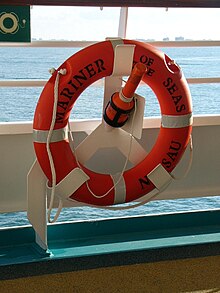

A lifebuoy or life ring, among many other names (see § Other names), is a life-saving buoy designed to be thrown to a person in water to provide buoyancy and prevent drowning. Some modern lifebuoys are fitted with one or more seawater-activated lights to aid rescue at night.
Other names
Other names for "lifebuoy" include:
- life preserver
- life ring
- lifering
- lifebelt
- lifesaver
- ring buoy
- donut
- safety wheel
- Perry buoy
- Kisbee ring
Description
The lifebuoy is usually a ring- or horseshoe-shaped personal flotation device with a connecting line allowing the casualty to be pulled to the rescuer in a boat. They are carried by ships and boats and located beside bodies of water and swimming pools. To prevent vandalism, they are protected by fines (up to £5,000 in the United Kingdom) or imprisonment.
In the United States, Coast Guard approved lifebuoys are considered Type IV personal flotation devices. At least one Type IV PFD is required on all vessels 26 feet or more in length.
In the UK the Royal Life Saving Society considers lifebuoys unsuitable for use in swimming pools because throwing one into a busy pool could injure the casualty or other pool users. In these locations, lifebuoys have been superseded by devices such as the torpedo buoy, a low-drag device developed to be towed by lifeguards to those in danger.
History
Leonardo da Vinci sketched a concept for a safety wheel, as well as for buoyant shoes and balancing sticks for walking on water.
According to various sources the Knights of Malta were the first to use cork lifebuoys on their ships.
In the book Architectura naval antigua y moderna (1752) by Juan José Navarro, 1st Marquess of Victoria, two plates show "circular lifebuoys" and another plate includes a drawing of "a lifebuoy made of cork", called "salvenos". This is the type used systematically by the Knights of Malta on their ships. The lifebuoy was attached to a rope on one side and to the poop of the ship on the other, so that it may be deployed in case anyone should fall into the sea. Navarro was Captain General of the Navy and is credited with the systematic introduction of the lifebuoy on all ships of the Spanish navy.
In 1803, a device called the "Marine Spencer" from the name of its inventor, Knight Spencer of Bread Street, was described in the Philosophical Magazine. It was made of "800 old tavern corks" affixed to a band, "covered in canvass, and painted in oil, so as to render it waterproof." The invention gained Spencer the honorary silver medal from the Royal Humane Society.
-
 Leonardo da Vinci's design sketches for a safety wheel
Leonardo da Vinci's design sketches for a safety wheel
-
 First studies on the lifebuoy illustrated in the Acta Eruditorum, 1691
First studies on the lifebuoy illustrated in the Acta Eruditorum, 1691
-
 Illustration of the prototype of the "Marine Spencer", an early example of lifebuoy, from the Philosophical Magazine, 1803
Illustration of the prototype of the "Marine Spencer", an early example of lifebuoy, from the Philosophical Magazine, 1803
Gallery
-
Commercial use lifebuoy aboard USCGC Eagle
-
Containered lifebuoy with concealed rope
-
Containered lifebuoy in Newport Beach, California
-
 Containered lifebuoy by the River Thames
Containered lifebuoy by the River Thames
-
 Older style of lifebuoy
Older style of lifebuoy
-
 Frost-covered lifebuoy, Lake Siskiyou, California
Frost-covered lifebuoy, Lake Siskiyou, California
-
 Lifebuoy in Ireland
Lifebuoy in Ireland
-
 Lifebuoy on a beach
Lifebuoy on a beach
-
 Lifebuoy at Tutjuniemi of Saaristo Harbour in Liperi, North Karelia, Finland
Lifebuoy at Tutjuniemi of Saaristo Harbour in Liperi, North Karelia, Finland
See also
- Personal flotation device – Equipment to help the wearer keep afloat in water
- Pool float, also known as swimming float – Device used to keep someone above water
- Swim ring – Inflatable water toy
References
- "The Kisbee Ring". Retrieved 2020-10-13.
- "Boat Life Rings, Ring Buoys". Retrieved 20 February 2023.
- "The Kisbee Ring". Retrieved 2020-10-13.
- "46 CFR 25.25-5 Life Preservers and Other Lifesaving Equipment".
- The Lifeguard. IQL UK Ltd. ISBN 1905008120.
- Wallace, Robert (1972) . The World of Leonardo: 1452–1519. New York: Time-Life Books. pp. 106–07.
- Hugo O'Donnell, 7th Duke of Tetuan (2004). El primer Marqués de la Victoria, personaje silenciado en la reforma dieciochesca de la armada: discurso leído el día 1 de febrero de 2004 (Real Academia de la Historia ed.). Real Academia de la Historia. pp. 46, 90. ISBN 978-84-96849-08-2.
{{cite book}}: CS1 maint: numeric names: authors list (link) - "Análisis y estudio del Album del Marques de la Victoria con proposito del su empleo en el modelismo de arsenal naval" (PDF). Archived from the original (PDF) on 2018-04-05. Retrieved 2024-03-15.
- "The philosophical magazine. Volume 16". 1803. pp. 172–173.
- "The Cristian Observer". September 1803. p. 568. Retrieved 2024-03-14.
External links
 Media related to Lifebuoys at Wikimedia Commons
Media related to Lifebuoys at Wikimedia Commons The dictionary definition of life jacket at Wiktionary
The dictionary definition of life jacket at Wiktionary
| Lifesaving and lifeguarding | ||
|---|---|---|
| International standards bodies |  | |
| National societies | ||
| Sub-national societies | ||
| Topics | ||
| Awards | ||
| Life-saving appliances | ||